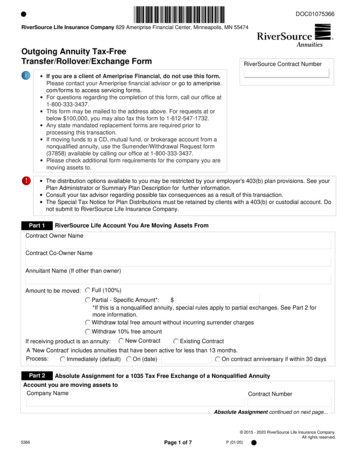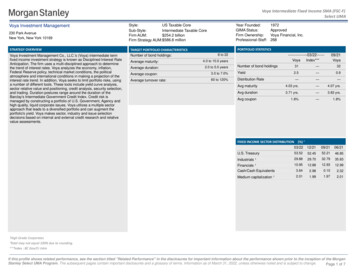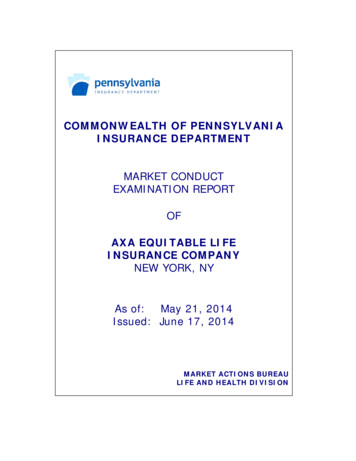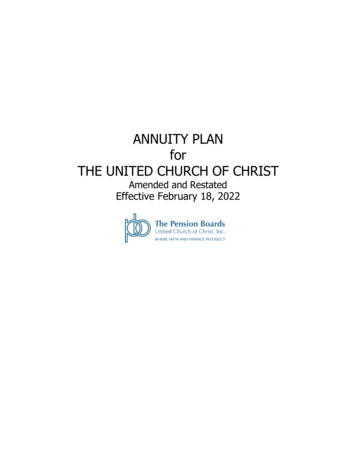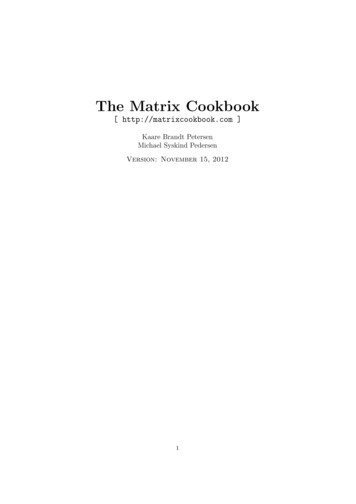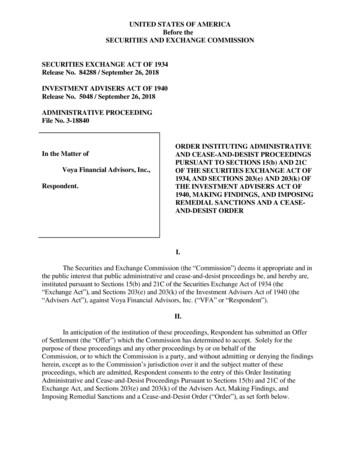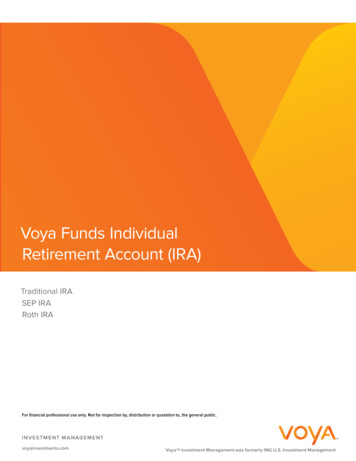
Transcription
Voya Equity Indexed Annuity Reserving APL ConversionGoldenson Center for Actuarial ResearchAugust, 20181 Page
Contents1. Algorithm . 32. Input . 143. Calculation and Output . 154. Appendix . 282 Page
1. AlgorithmThis document summarized the applied actuarial method of calculating three types of EIA reserves (GAAP, STAT, and Tax).1.1 General Applicable PrincipleSince this method is applied to EIA (Equity Indexed Annuity) reserving, each policy has multiple records of premium deposits (ortransitions) with different transaction dates. The total reserve of a policy is the sum of reserves based on each transaction (or deposit)of the policy. The order of records matters because it is assumed that withdrawals follow the rule of FIFO (first-in, first-out).Generally, the initial projection period is assumed to be 20 years. However, for different reserves, projection period may be applied indifferent ways based on some specific assumptions. For example, statutory projection period is determined by issue date, whereasGAAP projection period is based on transaction date. The general projection period, 20, is a cap for both of the two reserve. Thefollowing table shows the summary of the projection period in different reserve calculations.3 Page
Summary of Projection PeriodReservesVariablesGAAPHost as of issueCalculation Method of Projection PeriodFor each transaction, project the future 20 years cash flows (actually, theprojection time period is 15 years since there is an assumption of 100% lapserate after 15 years).Discount each future cash flow back to the corresponding transaction date.Host as of valuation dateEmbed optionAccumulate the host as of issue to the valuation date at an assumed interest rate.Project cash flows from the valuation date for the future(1 20 - (valuation date-transaction date)) years after valuation date.Calculate THE present value of each future cash flow at the valuation date.STAT/TAXCARVMProject account value from the valuation date for the future(22 - (valuation date-transaction date)) years for each transaction.Calculate present value of each future account value at the valuation date.CSV4 PageAccumulate each net deposit from the transaction date to the valuation date.
For the account value at the valuation date, firstly, each actual deposit is accumulated by an accumulation factor, and then lesswithdraw, thirdly, adjusted by assumed interest rate 0.06, from the transaction date to the sweep date. Detailed calculation can befound in 3.11, where REVAMT represents the account value at the valuation date. The accumulation factor can be looked up from thetable SWPRATES, which is supposed to be updated quarterly. The guaranteed account value at the valuation date is the 90% of eachdeposit accumulated from the corresponding transaction date to the valuation date at an assumed interest rate, 0.03. Detailedcalculation can be found in 3.13, where GMV represents the guaranteed account value.The market value of the option for different reserve uses different interest rates. Option value in STAT reserve is accumulated bySTATRATES. The option value in TAX reserve is calculated by TAXRATES. The option value in GAAP reserve is based on forwardrate.5 Page
1.2 US GAAP ReserveThe total US GAAP Reserve is the sum of the embedded option reserve as of valuation date (FAS157) and the host instrument valueas of the valuation date. The host as of valuation date equals to the host as of issue date accumulated by an implied interest rate duringthe projection period.1) Initial Bifurcation of Each Premium DepositThe account value is net deposit accumulated by the adjusted forward rate, which is BUD*(1 forward rate). BUD is an assumedrate 0.04. The forward rate is determined by the risk-free rate as of the greater of transaction date and 9/1/2009.The risk-free ratecan be searched from the table SPOTRATES.The embedded option is the account value less the greater of net deposit and non-forfeiture value. Liability cash flows are interestgenerated by the embedded option at the decrement rate during the projection duration. The projection duration is 20 years fromthe transaction date. The current decrement rates assume that the policy lapses in the 15th policy year, which is determined byTRT, a hard-coded variable in the original APL program.The embedded derivative reserve is the sum of discounted liability cash flows at the risk-free rate as of the transaction date. Pleasesee more detailed calculations in the formula 3.20. The host as of issue is the net deposit less the embedded option reserve. Thedetailed calculation method is mentioned in the formula 3.21. The implied host accretion rate is the interest rate that is used toaccumulate the host as of issue to non-forfeiture value. For more details, please see the formula 3.23.2) Embedded Derivative and Host Value as of Valuation Date6 Page
Account value is the general account value accumulated by adjusted forward rate, which is BRT*(1 forward rate). BRT isMarket value of optionOrig.Account valuein duration 1 and 0.04 afterwards. Forward rate is determined by risk-free rate searched from tableSPOTRATES as of valuation date. The market value of option is determined by the difference between option P and option S.Option P and S are calculated by Black-Scholes formula. The difference between the two option is the strike price. The price ofCAP Rateoption P is higher, since it has lower strike price, S&P 500. Whereas, the strike price of option S is (1 PARTICIPATE Rate) S&P 500. Please see more details in formula 3.16.The embedded option is the account value less the greater of net deposit and non-forfeiture value. The liability cash flows areinterest generated the embedded option in the projection duration. Projection duration is a remaining term, which can be explainedin the following example. A policy was issued on 08/25/1998. Policyholder made a deposit on 9/25/1998. Valuation date is3/31/2018. Then the valuation duration is 20, ceiling ((Val Date-Issue Date)/365). Transaction duration is 20, ceiling ((Val DateTrx Date)/365. Projection duration is 2, 1 max (20-Val Dur Trx Dur, 1)-floor ((Val Date-Trx Date)/365). The current decrementrates assume that the policy lapses in the 15th policy year, which is determined by TRT, a hard-coded variable in APL.Embedded derivative reserve is the sum of discounted liability cash flows at risk free rate as of valuation date. Please see moredetailed calculation in formula 3.24. Host as of valuation is the accumulated initial host during the period between transaction andvaluation date at rate of implied interest rate. The detailed calculation is mentioned in formula 3.25.7 Page
Host at ValuationHost at IssueEmbedded Option(FAS157)Liability CashFlows w/ AVGAAP Rsv8 PageEmbedded Optionat IssueLiability CashFlows w/ NetDeposit
1.3 Statutory ReserveStatutory reserve is the maximum of cash surrender value and statutory reserve using CARVM. CARVM is based on scenario tests,calculating the present value of the future death benefit and present value of the future cash surrender value under different assumeddurations and then choose the maximum value from the different scenarios. Cash surrender value is calculated as the projected accountvalue less surrender cost, where surrender cost is an assumption searched from table SC. Projected account value is the sum of accountvalue and STAT market value of option accumulated at 0.03 during projection period. Projection period is 22 less the policy year.Please refer formula 3.15 for detailed calculation information.9 Page
Account ValueCash Surrender ValueGuaranteed AccountSTAT RsvCash Surrender ValueSTAT CARVMSenarios w/ STAT RateDeath Benefit10 P a g e
Statutory reserve in CARVM is explained in the following example.11 P a g e
PVDB max(Guaranteed, Account Value Option) (q x (1 i)1 t 1 q x v t 2 q 73 v t 1 )PVCSV max(Guaranteed, Account Value Option) npx (1 i)Duration 20 RMNGTERMIn our example, the issue date is 9/11/1998 and valuation date is 3/31/2018. Then the duration is 20.STAT CARVM max(PVDB1, PVDB2 PVCSV2)Scenario 1PVDB1 max[REVPREM 0.9 1.0319 , REVAMT] q 73 (1 STATRT)1 RMNGTERMScenario 2PVDB2 PVDB1 max[REVPREM 0.9 1.0320 , REVAMT NETMV S] 1 q 73 (1 STATRT) RMNGTERMPVCSV2 max[REVPREM 0.9 1.0319 , REVAMT NETMV S] 2p73 (1 STATRT) RMNGTERMNETMV S NETMV (1 STATRT)RMNGTERMRMNGTERM max(1 12 P a g eVALDATE LKUPDT 1365, 0.0001)
1.4 Tax ReserveTax reserve is the minimum of statutory reserve and tax reserve using CARVM. The only difference between tax CARVM and statCARVM is the interest rate, where tax rate is used in tax CARVM.STAT RsvTAX RsvTAX CARVM13 P a g eSenarios w/ TAX Rate
2. InputIn the input text file, there are 17 columns, but only 15 of them will be used into the reserving calculation.1) POLICY: Policy number (one column)2) ISSDT/ISSDATE: issue date (three columns: year, month, date)3) ISSAGE: issue age (one column)4) SEX: gender (one column)5) LOB: line of business (one column)6) TRXDT/TRXDATE: transaction date (three columns: year, month, date)7) SWPDT/SWPDATE: sweep date (one column)8) SWPDAY: sweep date (one column)9) INITPREM: initial premium (one column)10) TOTWD: total withdraw (one column). For each policy there is only one total withdraw, which is just the sum up of all thewithdraws that already happened. This number is repeated in each record of the policy.11) TOTAV: total account value (one column). This number is as of sweep date directly. In the reserving calculation, we still needto calculate as of transaction date.12) Two state abbreviation columns, issue state and resident state.14 P a g e
3. Calculation and OutputIn the output text file, there are 28 columns. 8 of them come from the input file:1) Policy Input 1) POLICY2) LOB Input 5) LOB3) Issue Age Input 3) ISSAGE4) Sex Input 4) SEX5) Issue Date Input 2) ISSDT/ISSDATE6) Trans Date Input 6) TRXDT/TRXDATE7) Initial Deposit Input 9) INITPREM28) Vantage AV Input 11) TOTAVSo, there are still 20 columns we need to calculate (highlighted ones were already completed):8) WD from Dep/WDAMTWDAMT max (INITPREM – REVPREM, 0)REVPREM(t1) {1INITPREM(t) TOTWD(t), t 1INITPREM(t) RMNGWD0(t 1), t 1t: Index of each record (or row) for each policy, t 1 means the first and earliest transaction for each policy15 P a g e
TOTWD(t) INITPREM(t), t 1RMNGWD0(t) {RMNGWD0(t 1) INITPREM(t), t 19) Dep Net of WD/REVPREMPlease see bullet point 810) WD from AV/AV WDAV WD max (CURAMT – REVAMT, 0)SWPDATE TRXDATE365REVAMT Orig. REVAMT 1.06Org. REVAMT(t) {RMNGWD(t) {max(CURAMT(t) TOTWD(t), 0) , t 1max(CURAMT(t) RMNGWD(t 1), 0) , t 1TOTWD(t) CURAMT(t), t 1RMNGWD(t 1) CURAMT(t), t 1CURAMT INITPREM ACCUM FCTORACCUM FCTOR lookup (SWPRATES at SWPDATE)11) AV/REVAMTPlease see bullet point 10) for REVAMT12) WD from GMV/GUAR VALUE WDGUAR VALUE WD GMINAMT REVGMV16 P a g e
GMINAMT INITPREM 0.9 (1 VALDATE TRXDT2365ACCRATE)ACCRATE 0.03 for all policiesREVGMV(t) {GMINAMT(t) TOTWD(t), t 1GMINAMT(t) RMNGWD1(t 1), t 1TOTWD(t) GMINAMT(t), t 1RMNGWD1(t) {RMNGWD1(t 1) GMINAMT(t), t 113) GMV/REVGMVPlease see bullet point 12)14) CSVCSV max (REVAMT, REVGMV 0.1 REVGMV 0.9 (1 SC(DUR)))DUR VAL YEAR ISSUE YEAR (VAL MONTH 100 VAL DAY) (ISSUE MONTH 100 ISSUE DAY)SC [0.09, 0.09, 0.08, 0.07, 0.06, 0.05, 0.04, 0.03, 0.02, 0.01, 0, 0, 0 0], can be extended with 0If DUR 3, then SC(DUR) 0.08, the 3rd item of SC15) Stat RsvStat Rsv max(CSV, STAT CARVM)2APL does not take leap year into consideration. So, in date difference calculation, we assume there are 365 days for all years. In the excelmodel, we keep the same calculation as APL for testing purpose. While in the future, Voya may adjust the date difference to fit reality.17 P a g e
STAT CARVM maxi (PVDB(i)3 PVCSV(i))0, i 1PVCSV(i) {max(PROJGMV(i), PROJCSV(i)) PX(i) (1 STATRT)RMNGTERM 20 DUR , 1 i 22 DUR ,0, i 22 DURiPVDB(i) { max(PROJGMV(j), PROJCSV(j)) DEFQX(j) (1 STATRT)RMNGTERM j 2 , if i 22 DURj 10, i 22 DURPROJGMV(i) {PROJCSV(i) {REVPREM 0.9 1.03PREMDUR i 2 , i 22 DUR0, i 22 DURPROJAV(i) (1 (1 FWDPCT) SC(DUR)), if DUR 1PROJAV(i) (1 (1 FWDPCT) SC(DUR 1)), if DUR 1FWDPCT 0.1, for all policiesREVAMT, i 1PROJAV(i) {(REVAMT NETMV S) (1 ACCRATE)i 2 , 1 i 22 DUR0, i 22 DURNETMV S NETMV (1 STATRT)RMNGTERMSTATRT lookup(STATRTS at ISS YEAR)PREMDUR ISSYEAR TRXYEAR (ISS MONTH) TRX MONTH)3t: index of each record (or row) for each policy, t 1 means the first and earliest transaction for each policy. i: the i th column for each variable18 P a g e
QX q x lookup(MORTTBLS at the ceiling(ATTDAGE)), QX is a 1 by 15 array for each transactionif issyear 2000, lookup table IAM83, else lookup A2000, for female lookup column 3, male lookup column 2ATTDAGE ISSAGE VAL DATE ISSDATE365iiPX(i) (1 QX(i)) ipx (1 q j )j xj xDEFQX(i) PX(i 1) QX(i) i 1 q x i 1px qi16) Option MV/NETMVNETMV CALLMV NET PART REVAMTSWPINXCALLMV NET CALLMV P CALLMV SCALLMV P VALIDX e DIVRATE RMNGTERM N D1P SWPINX e RFRATE RMNGTERM N D2PN D1P normcdf(D1P)4N D2P normcdf(D2P)1VALIDXVALBID 2D1P (ln () (RFRATE DIVRATE ) (RMNGTERM))VAL BID RMNGTERMSI PUR24In APL, the cumulative distribution function of the standard normal distribution is estimated by some polynomial approximation method. However,in Excel, it can be avoided19 P a g e
D2P 1VALIDXVALBID 2(ln () (RFRATE DIVRATE ) (RMNGTERM))VAL BID RMNGTERMSI PUR2VAL BID 0.01 lookup(VALTBL at LKUPDT)CALLMV S VALIDX e DIVRATE RMNGTERM N D1S SI SAL e RFRATE RMNGTERM N D2SN D1S normcdf(D1S)N D2S normcdf(D2S)D1S 1VALIDXVAL ASK 2(ln () (RFRATE DIVRATE ) (RMNGTERM))VAL ASK RMNGTERMSI SAL21VALIDXVAL ASK 2D2S (ln () (RFRATE DIVRATE ) (RMNGTERM))VAL ASK RMNGTERMSI SAL2VAL ASK 0.01 lookup(VALTBL at LKUPDT)DIVRATE 0.0127507745 for all policiesRFRATE lookup (RFRATES at the RMNGTERM)RMNGTERM max(1 VALDATE LKUPDT 1365, 0.0001)LKUPDT MRSWPYR & TRX MONTH & SWPDAYMRSWPYR VAL YEAR (TRXMONTH VAL MONTH)SWPINX/SI PUR lookup(S&P500 Index at the LKUPDT)20 P a g e
CAPSI SAL (1 PART) SWPINX, where CAP lookup(PARTCAPS), PART lookup(PARTCAPS)17) GAVGAV (1 OPTCOST) REVAMT (1 GAAPRT)VALDATE LKUPDT365, whereOPTCOST 0.04 for all policies1GAAPRT {1 0.04 1, if REVAMT 00, Otherwise18) ING GAAP RsvINGGAAP GAV NETMV19) Tax RsvTax Rsv min(Stat Rsv, TAX CARVM)TAX CARVM maxi (PVDB(i) PVCSV(i))0, i 1PVCSV(i) {max(PROJGMV(i), PROJCSV(i)) PX(i) (1 TAXRT)RMNGTERM 20 DUR , 1 i 22 DUR ,0, i 22 DURiPVDB(i) { max(PROJGMV(j), PROJCSV(j)) DEFQX(j) (1 TAXRT)RMNGTERM j 2 , if i 22 DURj 10, i 22 DURPROJGMV(i) {21 P a g eREVPREM 0.9 1.03PREMDUR i 2 , i 22 DUR0, i 22 DUR
PROJCSV(i) {PROJAV(i) (1 (1 FWDPCT) SC(DUR)), if DUR 1PROJAV(i) (1 (1 FWDPCT) SC(DUR 1)), if DUR 1FWDPCT 0.1, for all policiesREVAMT, i 1PROJAV(i) {(REVAMT NETMV T) (1 ACCRATE)i 2 , 1 i 22 DUR0, i 22 DURNETMV T NETMV (1 TAXRT)RMNGTERMTAXRT lookup(TAXRTS at ISS YEAR)PREMDUR ISSYEAR TRXYEAR (ISS MONTH) TRX MONTH)QX q x lookup(MORTTBLS at ceiling(ATTDAGE)),QX is a 1 by 15 array for each transactionif issyear 2000, lookup table IAM83, else lookup A2000, for female lookup column 3, male lookup column 2ATTDAGE ISSAGE VALDATE ISSDATE365iiPX(i) (1 QX(i)) ipx (1 q j )j xDEFQX(i) PX(i 1) QX(i) 20) At Iss Emb Opt/EMBOPT22 P a g ej xi 1 q x i 1px qi
EMBOPT5 20 DROP2EO CF(i) DISC(i)i 1DISC(i) 1(1 RFR(i))iRFR 0.01 lookup(SPOTRTS at max(Transaction Date, 09/01/2009))DROP2 TDUR DUR DROP1TDUR Ceiling(TYRS)TYRS VALDT TRXDT365DUR Ceiling(YRS)YRS VALDT ISSDT365EO CF EO (BOY EOY)EO max(0, ASSUMD AV max(INITPREM WDAMT, MGV))ASSUMD AV(i) round6 ((INITPREM WDAMT) ij 1(1 AFG(j)), 2)AFG(i) BUD (1 FRT(i)), where BUD 0.04 for all policies56t represents the row number or the t th transaction for each policy, i represents column number of the variableIn APL the round (10.5, 2) represents10 2 floor(0.5 10.5 102 ) 10.5. In excel, we use round function to replace it23 P a g e
round(RFR(1), 6) , i 1FRT(i) {round ((1 RFR(i))i(1 RFR(i 1))i 1 1, 6) , i 1MGV(i) round(min(REVAMT, INITPREM WDAMT) MGCVPCT (1 GRT)i , 2), where MGCVPCT 0.9, GRT 0.031, i 1BOY(i) {BOY(i 1) (1 TRT(DROP1 i 1)) , i 1TRT [0.01, 0.01, 0.01, 0.01, 0.01, 0.02, 0.03, 0.04, 0.05, 0.05, 0.1, 0.1, 0.1, 0.1, 1, 1, ,1]EOY(i) {1 TRT(DROP1 1), i 1EOY(i 1) (1 TRT(DROP1 i)) , i 121) At Iss Host Inst/HOSTINSTHOSTINST INITPREM WDAMT EMBOPT22) At Iss Tot RsvAt Iss Tot Rsv EMB OPT HOSTINST23) Imp Int Rate/IMPINT0, HOSTINST 01IMPINT { MGV(20 DROP2) KEEP() 1,HOSTINSTKEEP MAX(20 DROP1,1)24 P a g eHOSTINST 0
24) Val Emb Opt/VEMBOPT20VEMBOPT EO CF(i) DISC(𝑖)i 11DISC(i) (1 RFR(i))RFR(i) {i floor(TYRS) TYRSOrig. RFR(floor(YTRS) i), i NUM 10, i NUM 1Orig. RFR 0.01 lookup(SPOTRTS at Valuation Date), where the size is t 22NUM KEEP floor(TYRS)EO CF EO (BOY EOY)EO(i) max (0, ASSUMD AV(i 1) max(INITPREM WDAMT, UGV(i 1)))REVAMT, i 1ASSUMD AV(i) {ASSUMD AV(i 1) (1 AFG(i 1)), 1 i NUM 10, i NUM 1AFG(i) {BRT(i) (1 FRT(i))floor(TYRS) 1 YTRSBRT(i) (1 FRT(i)), i 1NETMV,i 1BRT(i) {BUD 0.04, 1 i NUM0, i NUMREVAMT25 P a g e,i 1
RFR(i), i 2FRT(i) round ((1 RFR(i))i 1(1 RFR(i 1)){i 2 1, 6) , 2 i NUM 10, i NUM 1REVGMV, i 1UGV(i) {MGV(i 1 floor(TYRS)), 1 i NUM 10, i NUM 11, i 1BOY(i) {BOY(t, i 1) (1 TRT(DROP1 i 1 floor(TYRS))) , 1 i NUM0, i NUM(1 TRT(DROP1 1 floor(TYRS))) , i 1EOY(i) EOY(t, i 1) (1 TRT(DROP1 i floor(TYRS))) , 1 i NUM{0, i NUM25) Val Host Inst/VHOSTVHOST HOSTINST (1 IMPINT)TYRS26) Val Tot RsvVal Tot Rsv VEMBOPT VHOST27) FAS157 Emb Opt/VFEMBOPT20VFEMBOPT EO CF(i) DISC157(i)i 126 P a g e
DISC157(i) 1(1 RFR157(i))i floor(TYRS) TYRSRFR157(i) RFR(i) lookup(SPREADS at (i NUM) row and valuation date)27 P a g e
4. AppendixVariablesCategory7ACCUM FCTOR IColumnExplanationUsage8HAccumulation factorAMZ-NS for At Iss Emb OptAdjusted forward rateGAssumed account valueGSLTotal IFRS Reserve as of issue dateGATTDAGE MZAttained ageS, TAV WD OUActual total withdraw amount from account valueAAFG MYH-ZA for Val Emb OptASSMD AV MNT-OM for At Iss Emb OptZB-ZV for Val Iss Emb OptAt Iss Tot Rsv Oas of transaction dateBOY MPH-QA for At Iss Emb OptBeginning of the year rateGBud rateGAAQ-ABJ for Val Emb OptBRT M78XN-YGI represents input variable, O for output variable, M for intermediate variableS represents statutory reserve, T represents tax reserve, G represents GAAP reserve, A represents all three reserves28 P a g e
VariablesCategory7ColumnExplanationUsage8CALLMV NET MAZNet market value of the combination of call optionsACALLMV P MATMarket value of the call option PACALLMV S MAYMarket value of the call option SACSV OTCash value as of valuation dateS, TCURAMT MICurrent amount, accumulated deposit as ofAvaluation dateD1P MAPd1 of option PAD1S MAUd1 of option SAD2P MARd2 of option PAD2S MAWd2 of option SACK-CYDeferred mortality rateARP-SI for At Iss Emb OptDiscount factor, discounted risk-free rateGDEFQX MDISC MACY-ADR for Val EmbOpt29 P a g e
VariablesCategory7DISC157 MColumnADS-AEL for FAS157ExplanationUsage8Discount factor for FAS157GEmb OptDROP1 MKMDuration from each transaction to issueGDROP2 MKNDuration from each transaction to issueGS for STAT/TAXDuration from issue to valuation dateASJEmbedded option reserve as of issue dateGON-PG for At Iss Emb OptEmbedded optionGLiability cash flowGEnd of the year rateGDUR MKJ for GAAPEMBOPT OEO MZW-AAP for Val Emb OptEO CF MQV-RO for At Iss Emb OptACE-ACX for Val EmbOptEOY MQB-QU for At Iss Emb OptABK-ACD for Val EmbOpt30 P a g e
VariablesCategory7FRT MColumnLL-ME for At Iss Emb OptExplanationUsage8Forward rateGForward rate for FAS157GUH-VB for Val Emb OptFRT157 MVX-WR for FAS157 EmbOptGAAPRT MBAGAAP rateGGAV OBBGuaranteed account valueGJGuaranteed minimum amountS, TVWithdraw from guaranteed minimum valueS, THOSTINST OSKHost instrument at issueGIMPINT OSMImplied interest rateGINGGAAP OBDGAAP reserve based on eachGGMINAMT MGUAR VALUE WD Otransaction/deposit/premium, not the Total USGAAP to be reportedKEEP MLKUPDT M31 P a g eKODuration from transaction to terminationGAD-AELookup date for sweep rateS, T
VariablesCategory7MGV MColumnExplanationUsage8MF-MYMinimum guaranteed value for At Iss Emb OptGN D1P MAQN(d1) of option PAN D1S MAVN(d1) of option SAN D2P MASN(d2) of option PAN D2S MAXN(d2) of option SANETMV OBCMarket value of the optionANet market value of the guaranteed minimum returnNETMV S MBEStatutory market value of the optionSAccumulated net market value using stat rateNETMV T MBFTax market value of the optionSAccumulated net market value using tax rateNUM MOrg.REVAMT MOrig.RFR IPART I32 P a g eSNProjection duration for GAAP reserveGLOriginal revised account valueS, TSQ-TL for Val Emb OptSpot rate, risk free rateGAHParticipate rateG
VariablesCategory7PREMDUR MPROJAV MColumnExplanationUsage8YDuration from issue to transactionSCZ-DT for STATProjected account value using CARVMS, TProjected cash surrender value using CARVMS, TDU-EO for STATProjected guaranteed minimum amount usingS, TH-IF for TAXCARVMFZ-GN for STATPresent value of cash surrender value usingJQ-KE for TAXCARVMFK-FY for STATPresent value of death benefit using CARVMS, TGQ-HK for TAXPROJCSV MEP-FJ for STATIG-JA for TAXPROJGMV MPVCSV MPVDB MS, TJB-JP for TAXPX MBV-CJSurvival rateS, TQX MBG-BUMortality rateS, TRRevised account value, net account value afterAREVAMT Owithdraw as of valuation date33 P a g e
VariablesCategory7REVGMV OColumnMExplanationRevised guaranteed minimum value, net guaranteedUsage8Aminimum value after withdraw as of valuation dateREVPREM OKRevised premium, net premium after withdrawAAORisk free rateGKP-LK for At Iss Emb OptSpot rateGSpot rate for FAS157 Emb OptGAMRemaining termARMNGWD MORemaining withdrawARMNGWD0 MNRemaining withdrawARMNGWD1 MPRemaining withdrawAAIStrike price for the call option PASI SAL MAKStrike price for the call option SASTAT RSV OGPFinal statutory reserveSRFATE IRFR ITM-UG for Val Emb OptRFR157 MVC-VW for FAS157 EmbOptRMNGTERM MSI PUR/SWPINX M34 P a g e
VariablesCategory7STAT CARVM MColumnExplanationUsage8GOStatutory reserve using CARVMSSTATRT IWStat rateSTAX RSV OKGFinal tax reserveTTAX CARVM OKFTax reserve using CARVMTXTax rateTTDUR MKKDuration from transaction to valuation dateGTYRS MKJDuration from transaction to valuation dateGUGV MWS-XMMinimum guaranteed value for Val Emb OptGVal Tot Rsv OAEPTotal IFRS Reserve as of valuation dateGVAL ASK MAMAsk volatilityAVAL BID MALBid volatilityAVALIDX IAJIndex on the valuation date (spot price)AVantage AV OAEQSystem account valueAVEMBOPT OAEMEmbedded option as of valuation dateGVFEMBOPT OAENFAS157 embedded optionGTAXRT I35 P a g e
VariablesCategory7VHOST OWDAMT OColumnExplanationUsage8AEOHost instrument at valuation dateGQWithdraw amount, allocate total withdrawA(TOTWD) using FIFO (First In First Out)YRS MKHDuration from issue to valuation dateGNotice: Some variables do not have explanations since they are intermediate variables and difficult to explain the meaning. For thesevariables, please see the formulas in the excel model “Voya EIA Reserve Calculation (final version 3).xlsx”.36 P a g e
durations and then choose the maximum value from the different scenarios. Cash surrender value is calculated as the projected account value less surrender cost, where surrender cost is an assumption searched from table SC. Projected account value is the sum of account value and STAT market value of option accumulated at 0.03 during projection .


